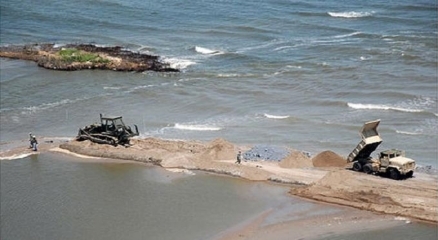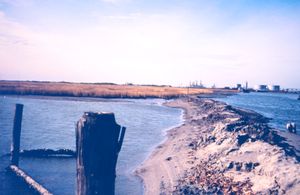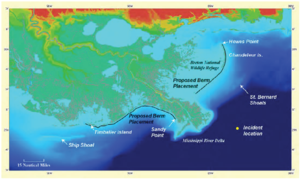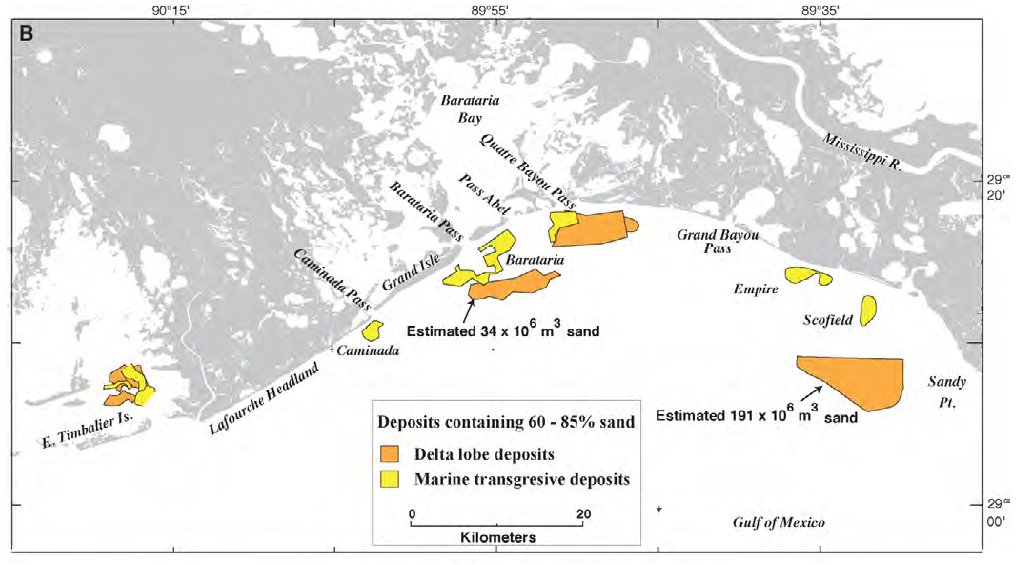Effects of sand barrier berms in Louisiana built to mitigate the effects of the Deepwater Horizon oil spill
Editor's Note: This article is excerpted directly from: Lavoie, Dawn1, Flocks, J.G.2, Kindinger, J.L.2, Sallenger, A.H.2, Jr., and Twichell, D.C.3, 2010, Effects of building a sand barrier berm to mitigate the effects of the Deepwater Horizon oil spill on Louisiana marshes: U.S. Geological Survey Open-File Report 2010–1108. It has been edited only to conform to the Encyclopedia's style guidelines.
Contents
Background
The State of Louisiana requested emergency authorization on May 11, 2010, to perform spill mitigation work on the Chandeleur Islands and on all the barrier islands from Grand Terre Island eastward to Sandy Point to enhance the capability of the islands to reduce the movement of oil from the Deepwater Horizon oil spill to the marshes. The proposed action— building a barrier berm (essentially an artificial island fronting the existing barriers and inlets) seaward of the existing barrier islands and inlets—“restores” the protective function of the islands but does not alter the islands themselves. Building a barrier berm (Louisiana berms project) to protect the mainland wetlands from oil is a new strategy and depends on the timeliness of construction to be successful. Prioritizing areas to be bermed, focusing on those areas that are most vulnerable and where construction can be completed most rapidly, may increase chances for success. For example, it may be easier and more efficient to berm the narrow inlets of the coastal section to the west of the Mississippi River Delta rather than the large expanses of open water to the east of the delta in the southern parts of the Breton National Wildlife Refuge (NWR). This document provides information about the potential available sand resources and effects of [[berm] construction] on the existing barrier islands.
The proposed project originally involved removing sediment from a linear source approximately 1 mile (1.6 km) gulfward of the barrier islands and placing it just seaward of the islands in shallow water (~2-m depth where possible) to form a continuous berm rising approximately 6 feet (~2 m) above sea level (North American Vertical Datum of 1988—NAVD88) with an ~110-yd (~100-m) width at water level and a slope of 25:1 to the seafloor. Discussions within the U.S. Geological Survey (USGS) and with others led to the determination that point-source locations, such as Hewes Point, the St. Bernard Shoals, and Ship Shoal, were more suitable “borrow” locations because sand content is insufficient along a linear track offshore from most of Louisiana’s barrier islands (fig. 1). Further, mining sediment near the toe of the barrier island platform or edge of actively eroding barrier islands could create pits in the seafloor that will capture nearshore sand, thereby enhancing island erosion, and focus incoming Waves (for example, through refraction processes) that could yield hotspots of erosion. In the Breton NWR, the proposed berm would be continuous from just south of Hewes Point to Breton Island for approximately 100 km with the exception of several passages for vessel access. Proposed volume estimates by sources outside of the USGS suggest that the structure in the Breton NWR would contain approximately 56 million cubic yards (42.8 m3) of sandy material. In the west, the berm would require approximately 36 million cubic yards (27.5 m3) of sandy material because this area has less open water than the area to the east of the delta. The planned berm is intended to protect the islands and inland areas from oil and would be sacrificial; that is, it will rapidly erode through natural processes. It is not part of the coastal restoration plan long discussed in Louisiana to rebuild barrier islands for hurricane protection of mainland infrastructure and habitat.
Potential Sand Resources
Sand resources along coastal Louisiana both east and west of the active delta are exceedingly scarce. Most suitable borrow material is from point sources within modern nearshore deposits or buried fluvial (river) deposits associated with earlier stages of delta formation (fig. 2A, B). The following paragraphs highlight the sand sources that may be most suitable for [[berm] construction]. East of the Mississippi River Delta in the Breton Sound segment of the berm project (fig. 2A), the permit application recommends that sediment be mined from Hewes Point for the northern parts of the berm and from St. Bernard Shoals for the southern parts of the berm in the Breton NWR. Hewes Point is an actively prograding spit that extends north of the Chandeleur Island chain. Analyses of geophysical and core data indicate that the spit contains 379 × 106 m3 of sediment in total and has a maximum thickness of 8.9 m (fig. 3). The core of the spit contains 97 percent well-sorted, very fine grained sand, decreasing to 90 percent 3.5 m below the seafloor. Sand content also decreases to 50 percent along the flanks of the spit. Hewes Point has prograded northward over the edge of older delta platform deposits into deeper water, thus providing a sediment sink. Material contained within Hewes Point likely will not be returned to the nearshore-barrier system naturally (Flocks and others, 2009; Twichell and others, 2009).
The St. Bernard Shoals are a group of 61 individual sand bodies located in 20 m of water approximately 25 km southeast of the Chandeleur Islands. The shoals contain an estimated 200 x 106 m3 of fine-grained, well-sorted, sandy sediment. Individual shoals consist of as much as 97 percent quartz sand, but sand content decreases to 20 percent at the flanks and between shoals. The shoals share a common fluvial source to the Chandeleur Islands, and characteristics of sand from both Hewes Point and St. Bernard Shoals are similar to sand found on the barrier island (Coastal zone)s (Coastal zone) shoreline (Rogers and Kulp, 2009).
Hewes Point and the St. Bernard Shoals provide a finite amount of high-quality sand material for restoration purposes. Removal of these sediment reservoirs for short-term protection of the barrier island (Coastal zone)s (Coastal zone) will reduce the amount of good-quality borrow material available for future long-term coastal restoration projects.
West of the Mississippi River Delta, the [[berm] proposal] includes a component along Louisiana’s southern barrier island (Coastal zone) shoreline. Because of the fine-grained nature of the deltaic deposits, the area has very limited amounts of sandy material. The proposal recommends [[berm] construction] extending from Timbalier Island to Sandy Point (fig. 1). The western third of this area is composed of the Lafourche headland (fig. 2B). The headland’s shoreline is composed of prodelta mud and beach ridge sands. In the offshore area, the beach ridge sands have been reworked to form a thin transgressive sand layer overlying the prodelta sediment. Sand is limited beyond the shoreface, and none of the available sand meets the minimum criteria, which is the percentage of sand within the deposit, for [[berm] construction] (Kindinger and others, 2001; Kulp and others, 2006).
East of the Lafourche headland, from Caminada Pass to Grand Bayou Pass (fig. 2B), the shoreline contains ebb-tide delta and shoreface and barrier deposits that provide sandy material to the offshore. These deposits include distinct sand packages in otherwise fine-grained shelf and deltaic deposits. This reach has potentially two surficial sand resource deposits—the distal ebb-tide delta deposits at Barataria and Quatre Bayou Passes (fig. 2B). From Pass Abel to Sandy Point (fig. 2B), two sand bodies—one surficial (Empire) and one with overburden (Sandy Point)—are potentially available for [[berm] construction]. A third sand body (Scofield) has been mined recently. The distal portion of the Empire sand body has potential as a sand resource. The best sand body of this area in proximity of the shoreline is Sandy Point, which is the largest and geomorphically most complex of the nearshore sand bodies. The Sandy Point sand body is overlain by 8–13 ft (2.4–3.7 m) of sediment. This overburden consists of numerous buried distributary channels filled with interbedded sands and clays. The large main sand body of Sandy Point has 20–30 ft (6.1–9.2 m) of 60–80 percent fine sand (Kindinger and others, 2001).

Issues Related to the Sand Berm

Numerous considerations have been identified by the USGS and collaborators that must be addressed when considering an alteration of the shoreface configuration:
- In light of the enormity of this project, it is critically important that the sand berm (Louisiana berms project) be constructed in a timely manner to ensure success. The most efficient means of achieving success will rely on prioritizing segments to be built in terms of potential ecological impacts.
- A second factor in prioritization is difficulty of construction. For example, after the recent [[hurricane]s], barrier islands no longer form a continuous chain from the northern tip of the Chandeleur Islands to Breton Island near the bird’s foot delta, a distance of approximately 100 km. Even prior to Hurricane Katrina, approximately 50 percent of this reach was open water, which the berm is intended to span. Here, the berm will be particularly vulnerable to destruction during storm (Tropical weather and hurricanes) surges and Waves. Building the berm in this open, deep water will require more mined sand to build the structure 2 m above sea level as designed.
- Studies of the Chandeleur Islands have shown that exceptionally large coastal changes can occur during [[storm (Tropical weather and hurricanes)]s (Tropical weather and hurricanes)] (Sallenger and others, 2009; fig. 4). During even relatively low-intensity [[storm (Tropical weather and hurricanes)]s (Tropical weather and hurricanes)], it is likely that the berm material will be overtopped by Waves and sand driven onto the island and possibly into the back bay (for example, see the overwash of Hurricane Lili (category 1) during 2002 (fig. 5) or Hurricane Ike (category 2) in 2008. Such overwash during [[storm (Tropical weather and hurricanes)]s (Tropical weather and hurricanes)] could transport oil and sediment across the island and into the back bays toward the mainland.
- East and west of the birdfoot, the reduction of inlets during [[berm] construction] will reduce the capacity of the inlets to handle the amounts of water exchanged by tides. Flow velocities will be rapid, and changes to the berm and islands will result. Salinity gradients and turbidity concentrations within the back-barrier bays will be altered, thus affecting the present ecosystem.
- With the profoundly fast time line needed to provide oil-spill protection, care must be taken to provide (1) sufficient oversight and (2) information regarding the adequacy of the borrow sites, the positions of pipelines and other obstructions that, if damaged, could exacerbate the ongoing spill, the effects on marine [[habitat]s], and the possibility that [[storm (Tropical weather and hurricanes)]s (Tropical weather and hurricanes)] may remove the berm so quickly that it does not serve its intended purpose.
- The sand berm (Louisiana berms project) is intended to be sacrificial. Although redistributing material within the system as it degrades will be beneficial in the long term, this project should not be confused with and will not have the longevity of a true barrier-island restoration.
- Sand resources along the Louisiana coastline are scarce. The excavation of this material for use in building an emergency berm may compromise future coastal restoration efforts by reducing the sand resources. Efficient and well-managed extraction and placement of these resources will be necessary.
- Under these emergency conditions with no time for adequate environmental assessment, long-term issues of concern include (1) entrainment of oil in the sediment plume created during dredging operations, (2) sequestration of the oil in sediments only to be released years later, and (3) anoxic conditions in the borrow areas. Monitoring will allow characterization of these potential conditions.
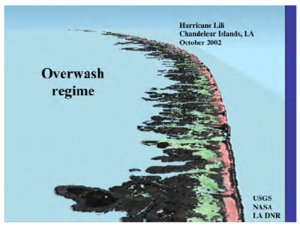
Long-Term Monitoring
Finally, long-term monitoring of the berm is recommended to determine its performance and possible impacts and benefits to the surrounding environment. Repeated surveys to update bathymetry, topography, seabed characteristics, and seabed images along with sediment sampling should be done to document changes through time. These observations and analyses will provide data needed to identify movement of oil and oil degradation through the system, determine impacts, and identify the processes involved. For example, monitoring changes in barrier topography and bathymetry along with analyses of sediment cores and oil-residue changes will show linkages between oil mobilization and sedimentary processes. Monitoring turbidity and salinity within the back-barrier environment either remotely or in situ using boat-mounted sensors will provide proxy information on estuarine health.
References
- Flocks, J., Twichell, D., Sanford, J., Pendleton, E., and Baldwin, W., 2009, Sediment sampling analysis to define quality of sand resources, Chapter F, in Lavoie, D., ed., Sand resources, regional geology, and coastal processes of the Chandeleur Islands coastal system—an evaluation of the Breton National Wildlife Refuge: U.S. Geological Survey Scientific Investigations Report 2009–5252, p. 99–124.
- Georgiou, I.Y., and Schindler, J., 2009, Numerical simulation of waves and sediment transport along a transgressive barrier island, Chapter H, in Lavoie, D., ed., Sand resources, regional geology, and coastal processes of the Chandeleur Islands coastal system—an evaluation of the Breton National Wildlife Refuge: U.S. Geological Survey Scientific Investigations Report 2009–5252, p. 143–168.
- Kindinger, J.L., Flocks, J.G., Kulp, M., Penland, S., and Britsch, L.D., 2001, Sand resources, regional geology, and coastal processes for the restoration of the Barataria Barrier shoreline: U.S. Geological Survey Open-File Report 01–384, 68 p., 5 pls., 2 CD-ROMs.
- Kulp, M.A., Penland, S., Flocks, J., and Kindinger, J., 2006, Regional geology, coastal processes, and sand resources in the vicinity of East Timbalier Island: U.S. Geological Survey Open-File Report 2006–1039, 73 p.
- Lavoie, D., Miner, M., Georgiou, I.Y., Fearnley, S., Sallenger, A.H., Jr., Williams, S.J., Twichell, D., Flocks, J., and Kulp, M., 2009, Summary and discussion, Chapter I, in Lavoie, D., ed., Sand resources, regional geology, and coastal processes of the Chandeleur Islands coastal system— an evaluation of the Breton National Wildlife Refuge: U.S. Geological Survey Scientific Investigations Report 2009–5252, p. 169–180.
- Lee, K., 2002, Oil-particle interactions in aquatic environments— influence on the transport, fate, effect and remediation of oil spills: Spill Science and Technology Bulletin, v. 8 no. 1.
- Miner, M.D., Kulp, M., Flocks, J., Twichell, D., Penland, S., Martinez, L., Motti, J., Weathers, D., DeWitt, N., Reynolds, B.J., Baldwin, W., Danforth, B., Worley, C., Bergeron, E., Ferina, N., McCarty, P., Brown, M., and Torres, J., 2009, Louisiana Barrier Island Comprehensive Monitoring Program, v. 3—south-central Louisiana and northern Chandeleur Islands, bathymetry and historical seafloor change 1873–2006, part 1—methods and error analysis for bathymetry: New Orleans, LA, University of New Orleans Pontchartrain Institute for Environmental Sciences Technical Report, submitted to Louisiana Department of Natural Resources, 44 p.
- Rogers, B., and Kulp, M., 2009, The St. Bernard Shoals—an outer continental shelf sedimentary deposit suitable for sandy barrier island renourishment, Chapter G, in Lavoie, D., ed., Sand resources, regional geology, and coastal processes of the Chandeleur Islands coastal system—an evaluation of the Breton National Wildlife Refuge: U.S. Geological Survey Scientific Investigations Report 2009–5252, p. 125–142.
- Sallenger, A.H., Jr., Wright, C.W., Howd, P., Doran, K., and Guy, K., 2009, Extreme coastal changes on the Chandeleur Islands, Louisiana, during and after Hurricane Katrina, Chapter B, in Lavoie, D., ed., Sand resources, regional geology, and coastal processes of the Chandeleur Islands coastal system—an evaluation of the Breton National Wildlife Refuge: U.S. Geological Survey Scientific Investigations Report 2009–5252, p. 27–36.
- Twichell, D., Pendleton, E., Baldwin, W., and Flocks, J., 2009, Geologic mapping of distribution and volume of potential resources, Chapter E, in Lavoie, D., ed., Sand resources, regional geology, and coastal processes of the Chandeleur Islands coastal system—an evaluation of the Breton National Wildlife Refuge: U.S. Geological Survey Scientific Investigations Report 2009–5252, p. 75–98.
EndNotes
1 U.S. Geological Survey, Office of the Eastern Region Executive, Gulf Coast Focus Area Coordinator, Stennis Space Center, Mississippi.
2 U.S. Geological Survey, St. Petersburg Coastal and Marine Science Center, St. Petersburg, Florida.
3 U.S. Geological Survey, Woods Hole Coastal and Marine Science Center, Woods Hole, Massachusetts.
